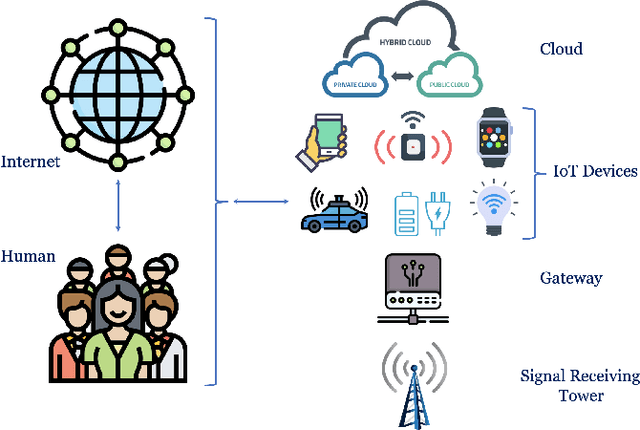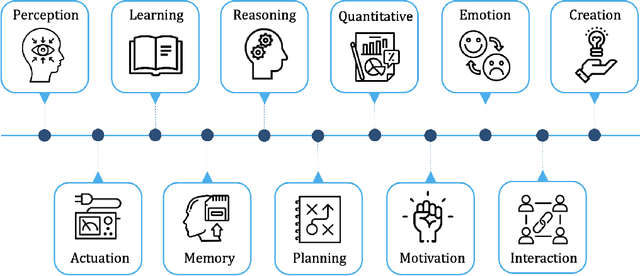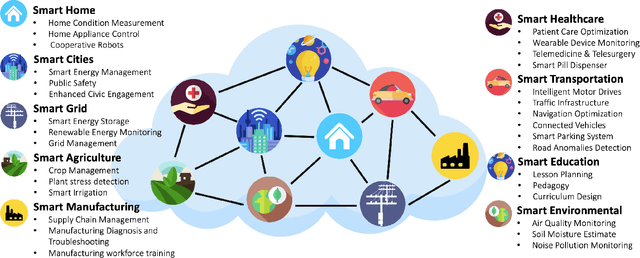Jin Sun
ZooplanktonBench: A Geo-Aware Zooplankton Recognition and Classification Dataset from Marine Observations
May 24, 2025Abstract:Plankton are small drifting organisms found throughout the world's oceans. One component of this plankton community is the zooplankton, which includes gelatinous animals and crustaceans (e.g. shrimp), as well as the early life stages (i.e., eggs and larvae) of many commercially important fishes. Being able to monitor zooplankton abundances accurately and understand how populations change in relation to ocean conditions is invaluable to marine science research, with important implications for future marine seafood productivity. While new imaging technologies generate massive amounts of video data of zooplankton, analyzing them using general-purpose computer vision tools developed for general objects turns out to be highly challenging due to the high similarity in appearance between the zooplankton and its background (e.g., marine snow). In this work, we present the ZooplanktonBench, a benchmark dataset containing images and videos of zooplankton associated with rich geospatial metadata (e.g., geographic coordinates, depth, etc.) in various water ecosystems. ZooplanktonBench defines a collection of tasks to detect, classify, and track zooplankton in challenging settings, including highly cluttered environments, living vs non-living classification, objects with similar shapes, and relatively small objects. Our dataset presents unique challenges and opportunities for state-of-the-art computer vision systems to evolve and improve visual understanding in a dynamic environment with huge variations and be geo-aware.
Enhancing Cognition and Explainability of Multimodal Foundation Models with Self-Synthesized Data
Feb 19, 2025Abstract:Large multimodal models (LMMs) have shown impressive capabilities in a wide range of visual tasks. However, they often struggle with fine-grained visual reasoning, failing to identify domain-specific objectives and provide justifiable explanations for their predictions. To address this, we propose a novel visual rejection sampling framework to improve the cognition and explainability of LMMs using self-synthesized data. Specifically, visual fine-tuning requires images, queries, and target answers. Our approach begins by synthesizing interpretable answers that include human-verifiable visual features. These features are based on expert-defined concepts, carefully selected based on their alignment with the image content. After each round of fine-tuning, we apply a reward model-free filtering mechanism to select the highest-quality interpretable answers for the next round of tuning. This iterative process of data synthesis and fine-tuning progressively improves the model's ability to generate accurate and reasonable explanations. Experimental results demonstrate the effectiveness of our method in improving both the accuracy and explainability of specialized visual classification tasks.
A Benchmark Dataset for Multimodal Prediction of Enzymatic Function Coupling DNA Sequences and Natural Language
Jul 21, 2024Abstract:Predicting gene function from its DNA sequence is a fundamental challenge in biology. Many deep learning models have been proposed to embed DNA sequences and predict their enzymatic function, leveraging information in public databases linking DNA sequences to an enzymatic function label. However, much of the scientific community's knowledge of biological function is not represented in these categorical labels, and is instead captured in unstructured text descriptions of mechanisms, reactions, and enzyme behavior. These descriptions are often captured alongside DNA sequences in biological databases, albeit in an unstructured manner. Deep learning of models predicting enzymatic function are likely to benefit from incorporating this multi-modal data encoding scientific knowledge of biological function. There is, however, no dataset designed for machine learning algorithms to leverage this multi-modal information. Here we propose a novel dataset and benchmark suite that enables the exploration and development of large multi-modal neural network models on gene DNA sequences and natural language descriptions of gene function. We present baseline performance on benchmarks for both unsupervised and supervised tasks that demonstrate the difficulty of this modeling objective, while demonstrating the potential benefit of incorporating multi-modal data types in function prediction compared to DNA sequences alone. Our dataset is at: https://hoarfrost-lab.github.io/BioTalk/.
Neural Gaffer: Relighting Any Object via Diffusion
Jun 11, 2024



Abstract:Single-image relighting is a challenging task that involves reasoning about the complex interplay between geometry, materials, and lighting. Many prior methods either support only specific categories of images, such as portraits, or require special capture conditions, like using a flashlight. Alternatively, some methods explicitly decompose a scene into intrinsic components, such as normals and BRDFs, which can be inaccurate or under-expressive. In this work, we propose a novel end-to-end 2D relighting diffusion model, called Neural Gaffer, that takes a single image of any object and can synthesize an accurate, high-quality relit image under any novel environmental lighting condition, simply by conditioning an image generator on a target environment map, without an explicit scene decomposition. Our method builds on a pre-trained diffusion model, and fine-tunes it on a synthetic relighting dataset, revealing and harnessing the inherent understanding of lighting present in the diffusion model. We evaluate our model on both synthetic and in-the-wild Internet imagery and demonstrate its advantages in terms of generalization and accuracy. Moreover, by combining with other generative methods, our model enables many downstream 2D tasks, such as text-based relighting and object insertion. Our model can also operate as a strong relighting prior for 3D tasks, such as relighting a radiance field.
ALDM-Grasping: Diffusion-aided Zero-Shot Sim-to-Real Transfer for Robot Grasping
Mar 18, 2024



Abstract:To tackle the "reality gap" encountered in Sim-to-Real transfer, this study proposes a diffusion-based framework that minimizes inconsistencies in grasping actions between the simulation settings and realistic environments. The process begins by training an adversarial supervision layout-to-image diffusion model(ALDM). Then, leverage the ALDM approach to enhance the simulation environment, rendering it with photorealistic fidelity, thereby optimizing robotic grasp task training. Experimental results indicate this framework outperforms existing models in both success rates and adaptability to new environments through improvements in the accuracy and reliability of visual grasping actions under a variety of conditions. Specifically, it achieves a 75\% success rate in grasping tasks under plain backgrounds and maintains a 65\% success rate in more complex scenarios. This performance demonstrates this framework excels at generating controlled image content based on text descriptions, identifying object grasp points, and demonstrating zero-shot learning in complex, unseen scenarios.
MVSA-Net: Multi-View State-Action Recognition for Robust and Deployable Trajectory Generation
Nov 18, 2023Abstract:The learn-from-observation (LfO) paradigm is a human-inspired mode for a robot to learn to perform a task simply by watching it being performed. LfO can facilitate robot integration on factory floors by minimizing disruption and reducing tedious programming. A key component of the LfO pipeline is a transformation of the depth camera frames to the corresponding task state and action pairs, which are then relayed to learning techniques such as imitation or inverse reinforcement learning for understanding the task parameters. While several existing computer vision models analyze videos for activity recognition, SA-Net specifically targets robotic LfO from RGB-D data. However, SA-Net and many other models analyze frame data captured from a single viewpoint. Their analysis is therefore highly sensitive to occlusions of the observed task, which are frequent in deployments. An obvious way of reducing occlusions is to simultaneously observe the task from multiple viewpoints and synchronously fuse the multiple streams in the model. Toward this, we present multi-view SA-Net, which generalizes the SA-Net model to allow the perception of multiple viewpoints of the task activity, integrate them, and better recognize the state and action in each frame. Performance evaluations on two distinct domains establish that MVSA-Net recognizes the state-action pairs under occlusion more accurately compared to single-view MVSA-Net and other baselines. Our ablation studies further evaluate its performance under different ambient conditions and establish the contribution of the architecture components. As such, MVSA-Net offers a significantly more robust and deployable state-action trajectory generation compared to previous methods.
Map2Schedule: An End-to-End Link Scheduling Method for Urban V2V Communications
Oct 12, 2023Abstract:Urban vehicle-to-vehicle (V2V) link scheduling with shared spectrum is a challenging problem. Its main goal is to find the scheduling policy that can maximize system performance (usually the sum capacity of each link or their energy efficiency). Given that each link can experience interference from all other active links, the scheduling becomes a combinatorial integer programming problem and generally does not scale well with the number of V2V pairs. Moreover, link scheduling requires accurate channel state information (CSI), which is very difficult to estimate with good accuracy under high vehicle mobility. In this paper, we propose an end-to-end urban V2V link scheduling method called Map2Schedule, which can directly generate V2V scheduling policy from the city map and vehicle locations. Map2Schedule delivers comparable performance to the physical-model-based methods in urban settings while maintaining low computation complexity. This enhanced performance is achieved by machine learning (ML) technologies. Specifically, we first deploy the convolutional neural network (CNN) model to estimate the CSI from street layout and vehicle locations and then apply the graph embedding model for optimal scheduling policy. The results show that the proposed method can achieve high accuracy with much lower overhead and latency.
Towards Artificial General Intelligence (AGI) in the Internet of Things (IoT): Opportunities and Challenges
Sep 14, 2023


Abstract:Artificial General Intelligence (AGI), possessing the capacity to comprehend, learn, and execute tasks with human cognitive abilities, engenders significant anticipation and intrigue across scientific, commercial, and societal arenas. This fascination extends particularly to the Internet of Things (IoT), a landscape characterized by the interconnection of countless devices, sensors, and systems, collectively gathering and sharing data to enable intelligent decision-making and automation. This research embarks on an exploration of the opportunities and challenges towards achieving AGI in the context of the IoT. Specifically, it starts by outlining the fundamental principles of IoT and the critical role of Artificial Intelligence (AI) in IoT systems. Subsequently, it delves into AGI fundamentals, culminating in the formulation of a conceptual framework for AGI's seamless integration within IoT. The application spectrum for AGI-infused IoT is broad, encompassing domains ranging from smart grids, residential environments, manufacturing, and transportation to environmental monitoring, agriculture, healthcare, and education. However, adapting AGI to resource-constrained IoT settings necessitates dedicated research efforts. Furthermore, the paper addresses constraints imposed by limited computing resources, intricacies associated with large-scale IoT communication, as well as the critical concerns pertaining to security and privacy.
Using Caterpillar to Nibble Small-Scale Images
May 28, 2023Abstract:Recently, MLP-based models have become popular and attained significant performance on medium-scale datasets (e.g., ImageNet-1k). However, their direct applications to small-scale images remain limited. To address this issue, we design a new MLP-based network, namely Caterpillar, by proposing a key module of Shifted-Pillars-Concatenation (SPC) for exploiting the inductive bias of locality. SPC consists of two processes: (1) Pillars-Shift, which is to shift all pillars within an image along different directions to generate copies, and (2) Pillars-Concatenation, which is to capture the local information from discrete shift neighborhoods of the shifted copies. Extensive experiments demonstrate its strong scalability and superior performance on popular small-scale datasets, and the competitive performance on ImageNet-1K to recent state-of-the-art methods.
SAM for Poultry Science
May 17, 2023Abstract:In recent years, the agricultural industry has witnessed significant advancements in artificial intelligence (AI), particularly with the development of large-scale foundational models. Among these foundation models, the Segment Anything Model (SAM), introduced by Meta AI Research, stands out as a groundbreaking solution for object segmentation tasks. While SAM has shown success in various agricultural applications, its potential in the poultry industry, specifically in the context of cage-free hens, remains relatively unexplored. This study aims to assess the zero-shot segmentation performance of SAM on representative chicken segmentation tasks, including part-based segmentation and the use of infrared thermal images, and to explore chicken-tracking tasks by using SAM as a segmentation tool. The results demonstrate SAM's superior performance compared to SegFormer and SETR in both whole and part-based chicken segmentation. SAM-based object tracking also provides valuable data on the behavior and movement patterns of broiler birds. The findings of this study contribute to a better understanding of SAM's potential in poultry science and lay the foundation for future advancements in chicken segmentation and tracking.
 Add to Chrome
Add to Chrome Add to Firefox
Add to Firefox Add to Edge
Add to Edge